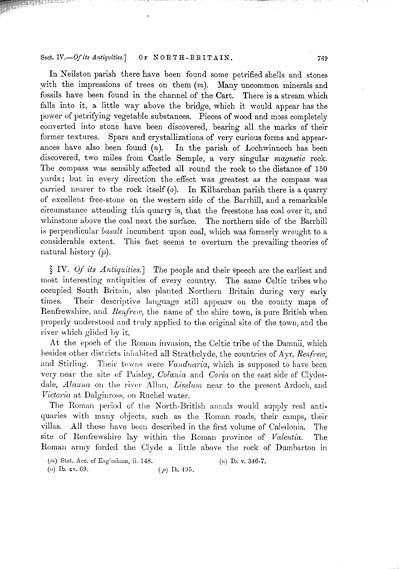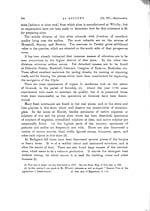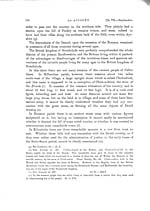Volume 6
(329) Page 769
Download files
Individual page:
Thumbnail gallery: Grid view | List view

769 In Neilston parish there have been found some petrified shells and stones with the impressions of trees on them (m). Many uncommon minerals and fossils have been found in the channel of the Cart. There is a stream which falls into it, a little way above the bridge, which it would appear has the power of petrifying vegetable substances. Pieces of wood and moss completely converted into stone have been discovered, bearing all the marks of their former textures. Spars and crystallizations of very curious forms and appear- ances have also been found (n). In the parish of Lochwinnoch has been discovered, two miles from Castle Semple, a very singular magnetic rock. The compass was sensibly affected all round the rock to the distance of 150 yards; but in every direction the effect was greatest as the compass was carried nearer to the rock itself (o). In Kilbarchan parish there is a quarry of excellent free-stone on the western side of the Barrhill, and a remarkable circumstance attending this quarry is, that the freestone has coal over it, and whinstone above the coal next the surface. The northern side of the Barrhill is perpendicular basalt incumbent upon coal, which was formerly wrought to a considerable extent. This fact seems to overturn the prevailing theories of natural history (p). � IV. Of its Antiquities. The people and their speech are the earliest and most interesting antiquities of every country. The same Celtic tribes who occupied South Britain, also planted Northern Britain during very early times. Their descriptive language still appears on the county maps of Renfrewshire, and Renfrew, the name of the shire town, is pure British when properly understood and truly applied to the original site of the town, and the river which glided by it. At the epoch of the Roman invasion, the Celtic tribe of the Damnii, which besides other districts inhabited all Strathclyde, the countries of Ayr, Renfrew, and Stirling. Their towns were Vanduaria, which is supposed to have been very near the site of Paisley, Colania and Coria on the east side of Clydes- dale, Alauna on the river Allan, Lindum near to the present Ardoch, and Victoria at Dalginross, on Ruchel water. The Roman period of the North-British annals would supply real anti- quaries with many objects, such as the Roman roads, their camps, their villas. All these have been described in the first volume of Caledonia. The site of Renfrewshire lay within the Roman province of Valentia. The Roman army forded the Clyde a little above the rock of Dumbarton in (m) Stat. Acc. of Eaglessham, ii. 148. (n) Ib. v. 346-7. (o) Ib. xv. 69. (p) Ib. 495.
Set display mode to:
![]() Universal Viewer |
Universal Viewer | ![]() Mirador |
Large image | Transcription
Mirador |
Large image | Transcription
Images and transcriptions on this page, including medium image downloads, may be used under the Creative Commons Attribution 4.0 International Licence unless otherwise stated. ![]()
| Caledonia, or, An account, historical and topographic of North Britain from the most ancient to the present times > Volume 6 > (329) Page 769 |
|---|
| Permanent URL | https://digital.nls.uk/74531688 |
|---|---|
| Description | Of its antiquities |
| Description | Vol. VI. |
|---|---|
| Attribution and copyright: |
|

